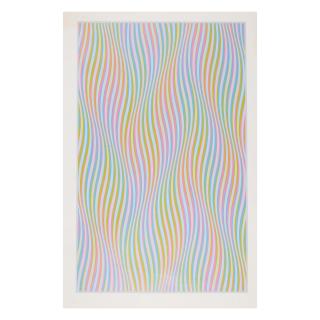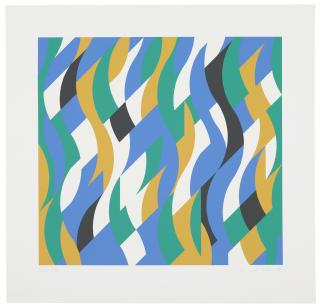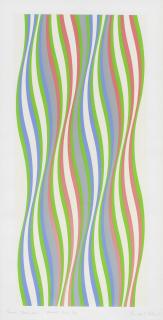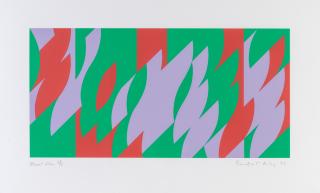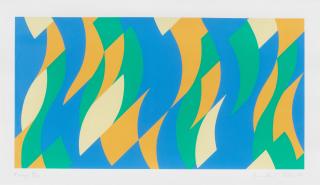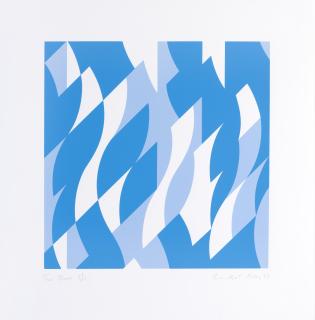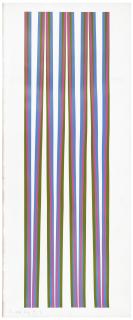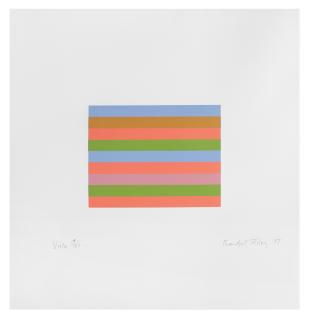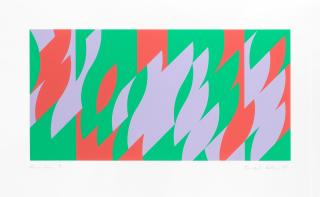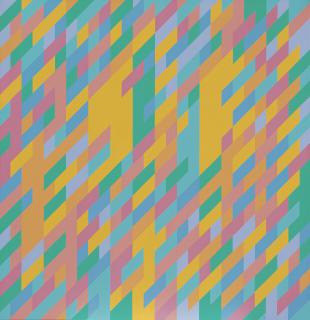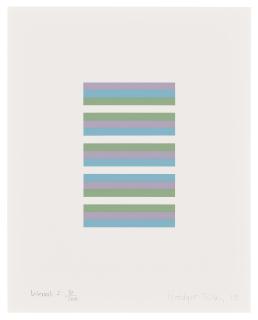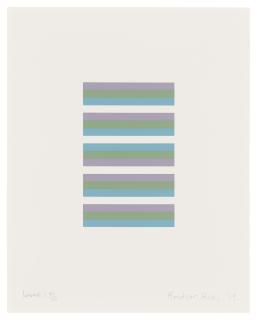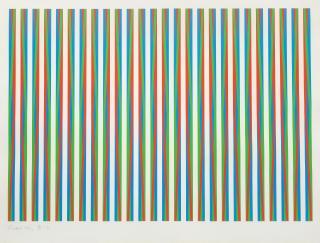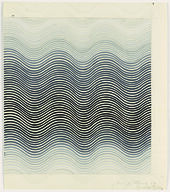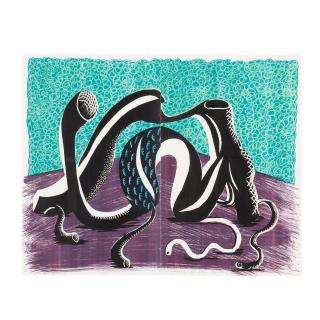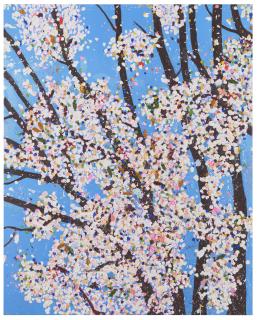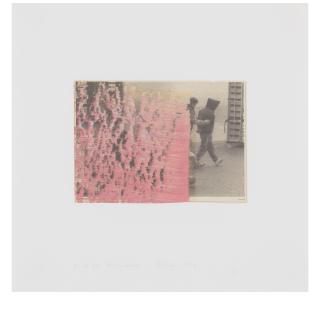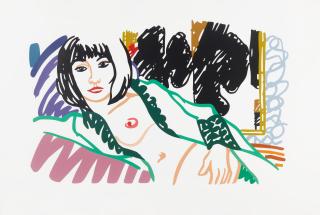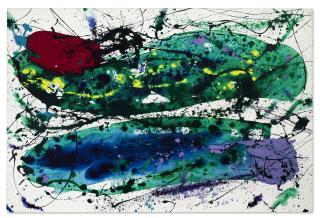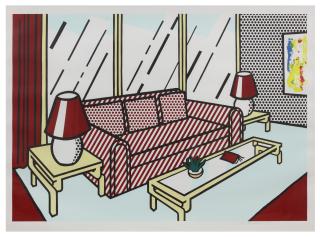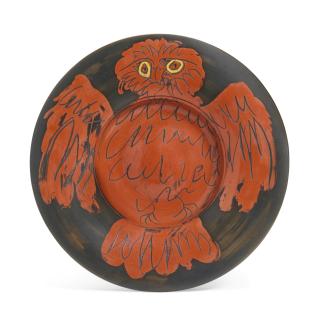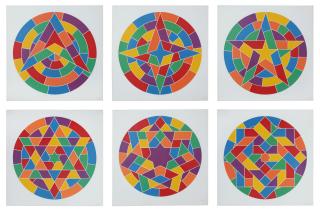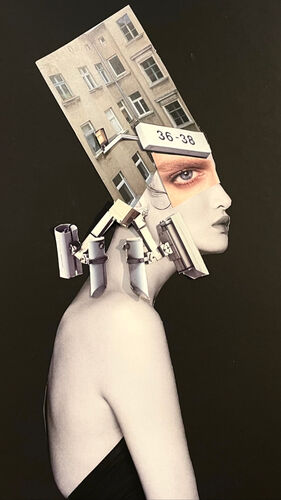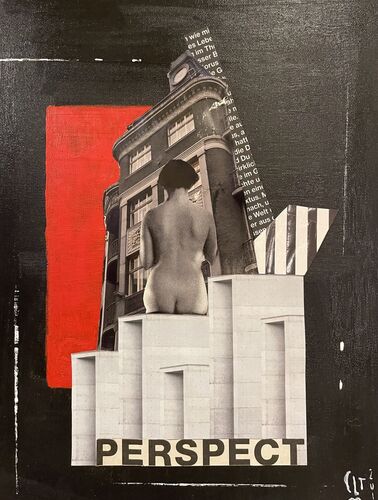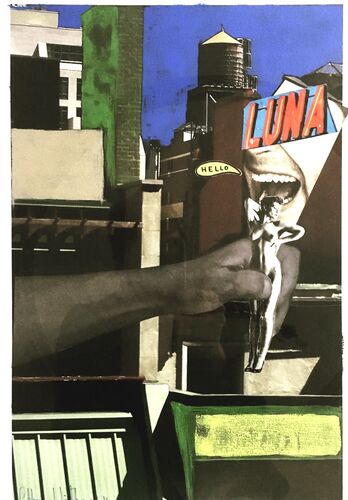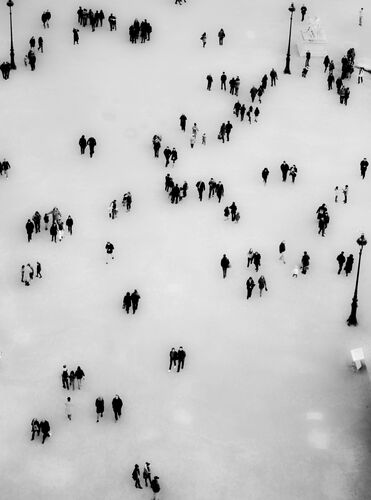Bridget Riley born 1931
The artist Bridget Riley
- British painter of the 20th century.
- Started with representational painting and later became a leading exponent of Op art.
- Was awarded both the Order of the British Empire and the Order of the Companions of Honour.
Bridget Louise Riley, born 24 April 1931 in West Norwood, London, is a British artist and exponent of Op art. Op art, which emerged in the 1960s, is also known as optical art and encompasses a field of abstract arts characterised by geometric forms with irritating or surprising effects (optical illusions).
Riley studied at Goldsmiths College in London from 1949 to 1952 and at the Royal College of Art from 1952 to 1955. She herself states that she was inspired by Georges Seurat's pointillist art in terms of colour, which provided her with a deeper understanding of colour perception. Later on, Riley is often compared with other Op-Art artists such as Victor Vasarely or Richard Anuszkiewicz.
Her Op Art works, however, stand out from their works above all because of their use of colour. Her orientation towards Seurat is still clearly discernible in her early work Pink Landscape from 1960, while some of her later and now well-known pieces Fall (1964) and Current (1964) are characterised by a purely black and white colour scheme.
The two paintings create optical illusions simply because of their undulating lines, which are misleading to the eye. Later she took up these motifs again and further intensified the effect by using colours - as in Cataract (1967) or Rill (1976). With Blaze 1 (1962), Shiver (1964) or Static 1 (1966), Riley designed impressive optical illusions that make their viewers believe that the image is moving.
In 1968, Riley received the International Prize for Painting at the Venice Biennale and was a participant in documenta 4 in the same year. Her artwork was also shown at documenta 6 in 1977. In 1974 she was awarded the Order of the British Empire and in 1998 also the Order of the Companions of Honour for her outstanding artistic achievements.
Die Künstlerin Bridget Riley
- Britische Malerin des 20. Jahrhunderts.
- Begann zunächst mit gegenständlicher Malerei und wurde später zu einer führenden Vertreterin der Op-Art.
- Wurde mit dem Order of the British Empire und dem Order of the Companions of Honour ausgezeichnet.
Bridget Louise Riley, geb. am 24.04.1931 in West Norwood, London, ist eine britische Künstlerin und Vertreterin der Op-Art. Die in den 1960ern entstandene Op-Art wird auch als optische Kunst bezeichnet und umfasst einen Bereich der präzisen abstrakten Kunst, die sich durch geometrische Formen mit irritierenden oder überraschenden Effekten (optische Täuschungen) auszeichnet Riley studierte von 1949 bis 1952 an der Londoner Kunsthochschule Goldsmiths College und von 1952 bis 1955 am Royal College of Art.
Sie selbst ließ sich ihren Angaben zufolge in Bezug auf Farben von der pointillistischen Kunst Georges Seurats inspirieren, die ihr ein tiefergehendes Verständnis von Farbwahrnehmung vermittelte. Später wird Riley oft mit anderen Op-Art-Künstlern wie Victor Vasarely oder Richard Anuszkiewicz verglichen. Ihre Op-Art-Werke heben sich aber vor allem durch ihre Farbgebung von deren Arbeiten ab.
Deutlich wird ihre Orientierung an Seurats noch in ihrem frühen Werk Rosa Landschaft von 1960, während einige ihrer später entstandenen und heute bekannten Stücke Fall (1964) und Current (1964) sich durch eine rein schwarzweiße Farbgebung auszeichnen. So erzeugen die beiden Bilder allein aufgrund ihrer für das Auge irreführenden, welligen Linienführung optische Illusionen. Später griff sie diese Motive wieder auf und intensivierte den Effekt weiter mittels des Einsatzes von Farben – wie etwa in Cataract (1967) oder Rill (1976).
Mit Blaze 1 (1962), Shiver (1964) oder Static 1 (1966) entwarf Riley beeindruckende optische Täuschungen, die ihre Betrachter glauben lassen, die Bildinhalte bewegten sich. 1968 erhielt Riley den Internationalen Preis für Malerei auf der Biennale in Venedig und war im selben Jahr Teilnehmerin der documenta 4. Auf der documenta 6 waren ihre Werke 1977 ebenfalls zu sehen. 1974 wurde sie mit dem Order of the British Empire und 1998 außerdem mit dem Order of the Companions of Honour für ihre herausragenden künstlerischen Leistungen ausgezeichnet.
Bridget Riley in a nutshell
Riley received her first artistic training as a 15-year-old at Cheltenham Ladies' College, where she was from 1946 to 1948. Already there, her teacher recognized her special talent and allowed her many freedoms away from her usual classes to further her artistic education. From 1949 to 1952, Riley studied at the renowned Goldsmiths College in London and then at the Royal College of Art until 1955, from which she graduated with a bachelor's degree. After her studies, Riley worked in various jobs such as saleswoman and teacher and cared for her father after a serious traffic accident. It wasn't until the 1960s that she produced her first op art paintings and her own career slowly took off.
Riley had her first solo exhibition in London in 1962 at Gallery One. She struck a chord with her paintings, and within a few years she was making a name for herself in the art world. Riley's first solo exhibition in New York in 1965 − at the Richard Feigen Gallery − was sold out before it even opened. Just three years later, Riley received the International Prize for Painting at the 34th Venice Biennale. This prize was the precursor of the Golden Lion we know today.
At the heart of Bridget Riley's art lies her extraordinary ability to create mesmerizing optical illusions that seem to defy the very fabric of reality. Her compositions pulse and vibrate with a sense of movement, inviting the viewer's gaze to dance across the canvas. Lines converge and diverge, shapes oscillate, and colors interact in harmonious disarray, producing a captivating symphony of visual rhythms. Through her meticulous manipulation of these elements, Riley crafts artworks that possess an uncanny ability to shift and transform.
Riley's art is a testament to the power of perception. Her works challenge the way we see and interpret visual information, prompting us to question the reliability of our senses. As viewers, we find ourselves entangled in a delicate web of illusion, struggling to discern where reality ends and illusion begins.
Bridget Riley's impact on contemporary art is profound and enduring. Her exploration of optical effects has paved the way for subsequent generations of artists to delve into the realm of perception and visual dynamics. From painting to digital art, Riley's influence is palpable, inspiring a continued fascination with the interplay of color, form, and movement.
However, Riley's art is not merely a visual spectacle; it is an experience. Her works demand active engagement, urging viewers to move, shift perspectives, and immerse themselves in the shifting patterns and rhythms before them. This participatory aspect transforms the act of viewing into an intimate dialogue between the artwork and the observer, blurring the boundaries between creator and receiver.
In addition to her award at the 34th Venice Biennale and other honors such as her induction into the Order of the Companions of Honor in 1998, two prizes in particular are important: In 2009, Riley received the coveted Goslar Kaiserring and in 2012 the Rubens Prize of the city of Siegen. The latter has been awarded only every five years since 1957 and has a prize purse of 25,000 euros in 2023. Riley was the second woman to be awarded the Rubens Prize, after Maria Lassnig in 2002.
Riley also received the Praemium Imperiale, also known as the »Nobel Prize of the Arts«, in 2003. The prize money is 15 million yen (approximately 96,000 euros in August 2023). Here, Riley was the first woman to receive the prize in the painting category.
As with many world-famous artists, the range is very wide, from a few hundred euros to millions. It depends mainly on the medium what the price is. Smaller drawings and prints cost a few hundred or a few thousand dollars, while important paintings regularly exceed the million-dollar mark. This is also the case with Bridget Riley, for whom over 30 paintings have sold at auction for more than $1 million. Most of the works that are traded, however, are in the range of $10,000 to $50,000.
Häufige Fragen zu Bridget Riley
Ihre erste künstlerische Ausbildung erfuhr Riley als 15jährige am Cheltenham Ladies‘ College, wo sie von 1946 bis 1948 war. Bereits dort erkannte ihr Lehrer ihre besondere Begabung und ermöglichte ihr viele Freiheiten abseits des gewöhnlichen Unterrichts, um sich künstlerisch weiterzubilden. Von 1949 bis 1952 studierte Riley das renommierte Goldsmiths College in London und anschließend bis 1955 das Royal College of Art, das sie mit einem Bachelor abschloss. Nach ihrem Studium arbeitete Riley in verschiedenen Berufen wie Verkäuferin und Lehrerin und pflegte ihren Vater nach einem schweren Verkehrsunfall. Erst in den 1960ern entstanden ihre ersten Op-Art-Bilder und ihre eigene Karriere nahm langsam ihren Anfang.
Ihre erste Einzelausstellung hatte Riley 1962 in London in der Gallery One. Sie traf mit ihren Bildern den Nerv der Zeit, den innerhalb weniger Jahre machte sie in der Kunstwelt von sich reden. Rileys erste Einzelausstellung in New York im Jahr 1965 – in der Richard Feigen Gallery – war bereits vor Eröffnung ausverkauft. Nur drei Jahre später erhielt Riley auf der 34. Biennale von Venedig den Internationalen Preis für Malerei. Dieser Preis war der Vorläufer des heute bekannten Goldenen Löwen.
Im Mittelpunkt von Bridget Rileys Kunst steht ihre außergewöhnliche Fähigkeit, faszinierende optische Täuschungen zu schaffen, die die Realität zu sprengen scheinen. Ihre Kompositionen pulsieren und vibrieren mit einem Gefühl der Bewegung und laden den Blick des Betrachters ein, über die Leinwand zu tanzen. Linien konvergieren und divergieren, Formen oszillieren, und Farben interagieren in harmonischem Durcheinander und erzeugen eine fesselnde Symphonie visueller Rhythmen. Durch ihre akribische Manipulation dieser Elemente schafft Riley Kunstwerke, die eine unheimliche Fähigkeit zur Veränderung und Transformation besitzen.
Rileys Kunst ist ein Zeugnis für die Macht der Wahrnehmung. Ihre Werke stellen die Art und Weise, wie wir visuelle Informationen sehen und interpretieren, in Frage und veranlassen uns, die Zuverlässigkeit unserer Sinne zu hinterfragen. Als Betrachter finden wir uns in einem delikaten Netz von Illusionen wieder, in dem wir darum kämpfen, zu erkennen, wo die Realität endet und die Illusion beginnt.
Bridget Rileys Einfluss auf die zeitgenössische Kunst ist tiefgreifend und nachhaltig. Ihre Erforschung optischer Effekte hat den Weg für nachfolgende Künstlergenerationen geebnet, sich mit dem Bereich der Wahrnehmung und der visuellen Dynamik zu befassen. Von der Malerei bis zur digitalen Kunst ist Rileys Einfluss spürbar und inspiriert eine anhaltende Faszination für das Zusammenspiel von Farbe, Form und Bewegung.
Rileys Kunst ist jedoch nicht nur ein visuelles Spektakel, sie ist eine Erfahrung. Ihre Werke fordern die Betrachter auf, sich aktiv einzubringen, die Perspektive zu wechseln und in die sich verändernden Muster und Rhythmen einzutauchen. Dieser partizipatorische Aspekt verwandelt den Akt des Betrachtens in einen intimen Dialog zwischen dem Kunstwerk und dem Betrachter und lässt die Grenzen zwischen Schöpfer und Empfänger verschwimmen.
Neben ihrer Auszeichnung auf der 34. Biennale von Venedig und weiteren Ehrungen wie ihre Aufnahme in den Order of the Companions of Honour 1998 sind zwei Preise im Besonderen wichtig: Im Jahr 2009 erhielt Riley den begehrten Goslarer Kaiserring sowie 2012 den Rubenspreis der Stadt Siegen. Letzterer wird seit 1957 nur alle fünf Jahre vergeben und hat im Jahr 2023 ein Preisgeld von 25.000 Euro. Riley war nach Maria Lassnig 2002 die zweite Frau, die mit dem Rubenspreis ausgezeichnet wurde.
Außerdem erhielt Riley im Jahr 2003 den Praemium Imperiale, der auch als »Nobelpreis der Künste« bekannt ist. Das Preisgeld beträgt 15 Millionen Yen (circa 96.000 Euro im August 2023). Hier war Riley in der Kategorie Malerei die erste Frau, die den Preis erhielt.
Wie bei vielen weltberühmten Künstlerinnen und Künstlern liegt die Spanne sehr weit, von wenigen hundert Euro bis zu Millionenbeträgen. Dabei hängt es vor allem vom Medium ab, wie der Preis aussieht. Kleinere Zeichnungen und Drucke kosten wenige hundert oder wenige Tausend Dollar, bedeutende Gemälde überschreiten regelmäßig die Millionengrenze. So verhält es sich auch bei Bridget Riley, bei der über 30 Gemälde bei Auktionen für mehr als 1 Million Dollar verkauft wurden. Die meisten Werke, die gehandelt werden, bewegen sich jedoch im Rahmen zwischen 10.000 und 50.000 Dollar.

